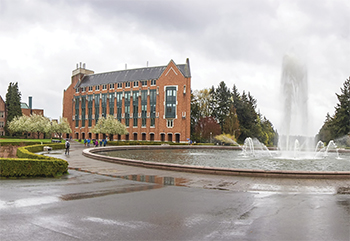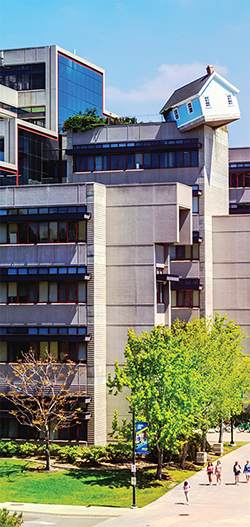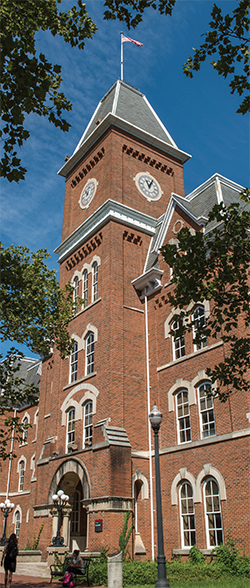Ph.D. outcomes тАФ one university at a time
In addition to the statistics compiled by the Bureau of Labor Statistics and the National Science Foundation that we used to create the graphs and maps, we asked biochemistry and molecular biology departments at universities across the U.S. to send us information about where their students go after earning a Ph.D. We did not intend to do a statistical survey but rather to get snapshots from around the country.
We asked:
- What share of Ph.D.s move right into academic/teaching positions?
- How many get jobs in industry?
- How many pursue postdocs?
- What kind of nontraditional outcomes do you see?
- Has this picture changed in the past decade or so?
- What steps has your department taken to support students who chose careers other than academic research?
- We heard back from six universities. Below are their responses, edited for length and clarity.
University of California, Los Angeles

, Los Angeles, tracks the career paths of our Ph.D. alumni.
Research-active BMSB faculty have reported on 325 alumni spanning the years of 1971 to 2018. More than 32% of these alumni currently are employed in industry, 18% are in academic research and teaching, 13% do research in an academic or government lab, and 13% are postdoctoral fellows.
Of the remaining alumni, 5% teach at a college or university, 5% work in medical or healthcare professions, 4% work in law/patent/financial institutions, 2% are consultants and 7% are categorized as other/unknown.
Data from recent 2015 to 2018 graduates indicate that nearly 50% start their careers as postdocs and 33% get a position in industry.
Our graduate students invite alumni from diverse backgrounds and careers to give seminars about their career paths. This facilitates networking among our current students, faculty and alumni and generates internships and support.
— Catherine Clarke, Professor and Chair
Department of Chemistry and Biochemistry
The Pennsylvania State University

The strives to promote the success of students with diverse academic interests and career goals. For students interested in exploring their options, we initiated an invited speaker series on career opportunities, and we have increased formal training in pedagogy, communication and professional-development skills that are useful in a wide range of careers.
Although our graduates ultimately work in a wide variety of careers, most decide that an academic postdoc is their best first step after obtaining their Ph.D. From 1998 to 2008, 70% of Ph.D. graduates started with a postdoctoral position. That percentage declined from 2010 to 2015, with a concomitant increase in graduates directly entering teaching and industry positions. From 2015 to the present, we have seen a return to the historical rate of 70% postdoctoral positions.
Most graduates who do not follow the postdoctoral path start with a job in an industry or government lab. Over the past 10 years, 16% of graduates have taken an industry position, 9% have started in a government lab, and 6% have moved directly to a teaching job. Other graduates have started in patent law, science writing or business.
— Kenneth Keiler, Professor and Associate
Head for Graduate Education, Department of
Biochemistry and ═╡┼─═╡┐· Biology
Washington University in St. Louis

About 73% of progress to postdoctoral positions. While the number proceeding directly to industry positions after graduation is only about 9%, more graduates have been moving toward industry over the past decade. As alumni move on to their second, third and fourth jobs, the industry number increases to 30%. About 5% move to other careers that are not in academia or industry.
We take pride in the multiple destinations of our graduates. We have received enthusiastic feedback about the performance of industry Ph.Ds. in both traditional and nontraditional industry roles.
We believe in the broader value of doctoral training and are introducing new innovations into the graduate curriculum to help students excel in both academia and industry.
These include science communication, biotech industry inclusion and expanded career planning, as well as support of career-development groups. We aim to equip our graduates to succeed in a variety of pathways after graduation.
Note: Our biology and biomedical sciences graduate programs are administered through the Division of Biology and Biomedical Sciences, or DBBS, with support and input from both preclinical and clinical department faculty. Washington University’s new BBSB program includes faculty and students from the previous biochemistry and computational and molecular biophysics programs. These statistics represent past and present programs in biochemistry and molecular biophysics.
— Jeffrey P. Henderson, Co-director
Biochemistry, Biophysics and Structural
Biology Graduate Program
— Andrew Richards, DBBS Director
of Recruitment, Admissions and Alumni Affairs
University of California, San Diego

In the , the largest percentage of our Ph.D. students, 44%, goes directly into postdoctoral positions at four-year colleges and universities. Almost as many, 40%, pursue positions in industry. Six percent of our graduates have secured positions in national laboratories. Of the remainder, 3% initially take positions at university-affiliated research institutes, 3% have adjunct faculty positions at community colleges and 3% have positions in government. These initial placement trends have been relatively consistent over the past several years.
To support our graduate students in their efforts to pursue careers outside of academia, we host a number of industry events throughout the year, which include networking and career panel sessions with successful industry professionals. We also have organized a number of group tours to local industry companies, and we encourage our graduate students to pursue summer industry internships when these opportunities arise.
— Erica Lennard, Director of Student Affairs,
Department of Chemistry and Biochemistry
The Ohio State University

Roughly half the students earning a Ph.D. in the still seek a postdoctoral position immediately after graduation. Jobs in industry (including consulting) are now the next most-frequent outcome, typically about 25% of graduates. Over the past 10 years, more students have been pursuing additional professional degrees (law or medicine) and other paths, such as government positions or clinical trials administration.
Our program is getting away from characterizing “nontraditional” career paths as alternative outcomes, and we embrace opportunities that are aligned better with students’ diverse interests and career goals. Students tell us what career support they want and need, and we focus our efforts and funding on the most current and relevant needs. For example, along with three other life sciences graduate programs, we host a student-run biannual career day, where students select and invite speakers (including many program alumni) who represent a wide array of career paths.
As a large public research university, our career-development infrastructure includes an entrepreneurship institute started by our business school. We have embraced partnerships with several National Institutes of Health-funded training-grant programs that help students gain internships in nonacademic fields and encourage early career planning.
— Jane E. Jackman, Director, Ohio State Biochemistry Program;
Professor, Department of Chemistry and Biochemistry
University of North Carolina at Chapel Hill

The graduate education office at the University of North Carolina at Chapel Hill tracks the outcomes of its graduates. From 2000 to 2018, more than 1,400 Ph.D. students graduated; we have outcome data for 93% of them. About 60% do postdoctoral training for more than 12 months, and the other 40% enter the workforce directly or after a short postdoc, often in their Ph.D. lab.
Removing postdocs from the analysis, 42% of life science Ph.D. alumni are in academia and 37% work at for-profit companies. Common jobs in academia are faculty member, health care provider, senior scientist/technical director, lecturer/instructor and program administrator. Top job functions in the for-profit sector include group leadership, researching, science writing and communication, business development, and regulatory affairs.
In all job sectors, 47% of our alumni are in career paths defined as primarily research, and 32% are in science-related careers that support the research enterprise in business development, consulting, clinical research management, program direction, intellectual property and other niche careers.
These data inform our professional-development program, including creating and advising student-led career groups, building employer relations and internship partnerships, and renewing and applying for National Institutes of Health funding.
— Patrick Brandt, Director of Career Development and Outreach
— Jean Cook, Professor of Biochemistry and Biophysics, Associate Dean
for Graduate Education
University of Toronto
 Marcus Obal/Wikimedia Commons
Marcus Obal/Wikimedia Commons
The at the University of Toronto determined the current employment positions of Ph.D.s who graduated from 2000 to 2015.
Of the 3,700 life sciences graduates, 18% are tenure-track professors, 29% are in other academic roles as postdocs or in teaching or administrative positions, 18% are in biotech or pharma, and 19% are in the public or charitable sectors (16% could not be identified by online searches).
Since the majority of Ph.D.s do not become university professors, the department of biochemistry created a for-credit professional development course for graduate students to develop their skills and network to be market-ready for positions in academia and beyond.
— Reinhart Reithmeier, Professor, Department of Biochemistry
Add your outcomes
This is just the beginning. The editors of ASBMB Today want to expand the online version of this article to include more universities. If your department would like share your answer to the six questions in the introduction at left, please email your information (50-100 words) to ASBMB Today using the subject line “Ph.D. outcomes.”
Enjoy reading ASBMB Today?
Become a member to receive the print edition four times a year and the digital edition weekly.
Learn moreFeatured jobs
from the
Get the latest from ASBMB Today
Enter your email address, and weтАЩll send you a weekly email with recent articles, interviews and more.
Latest in Careers
Careers highlights or most popular articles

Upcoming opportunities
Just added: Register for ASBMB's virtual session on thriving in challenging academic or work environments.

Who decides when a grad student graduates?
Ph.D. programs often donтАЩt have a set timeline. Students continue with their research until their thesis is done, which is where variability comes into play.

Upcoming opportunities
Submit an abstract for ASBMB's meeting on ferroptosis!

Join the pioneers of ferroptosis at cell death conference
Meet Brent Stockwell, Xuejun Jiang and Jin Ye тАФ the co-chairs of the ASBMBтАЩs 2025 meeting on metabolic cross talk and biochemical homeostasis research.

A brief history of the performance review
Performance reviews are a widely accepted practice across all industries тАФ including pharma and biotech. Where did the practice come from, and why do companies continue to require them?

Upcoming opportunities
Save the date for ASBMB's in-person conferences on gene expression and O-GlcNAcylation in health and disease.

